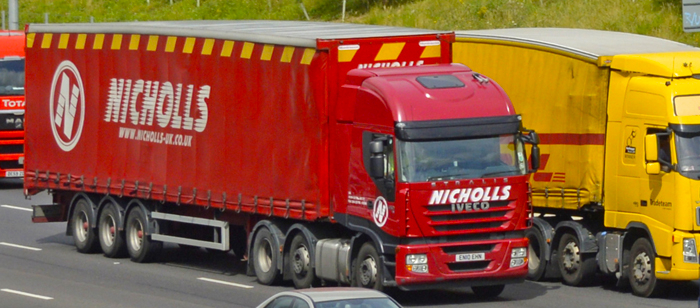Government to increase HGV speed limits

The government is currently processing new laws for England and Wales that will see the maximum national speed limits applicable to HGVs over 7.5 tonnes increase on 6th April 2015 to limits more suited to modern vehicles and haulier’s operational practices.
On single carriageway roads the limit will increase from 40mph to 50mph and on dual carriageways from 50mph to 60mph, even though HGVs are speed restricted to 56mph by EU legislation.
There are no current plans to increase limits in Scotland or Northern Ireland, any such changes would be introduced by the Scottish Parliament or the Northern Ireland Assembly. That said, Scotland took the lead on increasing limits when on 28th October 2014 the speed for HGVs rose on the single carriageway sections of the A9 between Perth and Inverness from 40mph to 50mph accompanied with average speed camera enforcement.
The change will remove the 20mph differential between HGVs and cars and it is aimed at improving traffic flow, reducing congestion, reducing journey times, reducing accidents caused by dangerous overtaking and improving operational efficiency. It also better aligns HGV speed limits with those of cars towing caravans and coaches.
A survey commissioned by the AA last year revealed that over 80% of drivers were unaware of HGV speed limits on single carriageway roads so it’s easy to see how ignorance leads to frustration and HGV drivers become wrongly viewed as being obstructive.
The current 40mph speed limit on single carriageway roads for HGVs was introduced in the 1960’s when trucks were less able to travel at speed and traffic was much lighter. Modern HGVs with their current technology are much heavier but are more environmentally friendly and more fuel efficient than their predecessors, and current limits do not reflect their capability to travel faster, but with increased safety. Independent experts do not expect road safety to be to be adversely effected, but it will be monitored closely once the increased limits come into force.
Maximum weight HGVs are geared to be most efficient travelling between 50 to 56mph. On single carriageway roads modern HGVs travelling at 40 mph do so whilst not in top gear. Therefore the vehicle is revving more, using more fuel, making more noise and increasing the carbon footprint. If it has automatic transmission it will also be constantly changing between gears unless the driver holds it in a lower gear. It is also more difficult to build and maintain momentum affecting its overall performance. Increasing the speed limit should therefore make it environmentally friendlier and more fuel efficient.
Motoring organisations have largely endorsed increasing the speed limits, but road safety charities do not agree with it, one citing that the increase is against current initiatives to manage traffic speeds and it will also lead to an increase in emission levels. Road safety campaigners claim that it risks increasing death and serious injuries as impact speeds would be higher. It is also suggested that more HGV’s may start to use single carriageway roads because at higher speeds they become a faster route which could adversely affect any traffic flow improvements.
Cycling charities seem unfazed as most accidents between HGVs and cyclists occur in urban environments at low speed. However, they also voice concerns about potential accident impact speeds and that HGVs overtaking cyclists at speed on single carriageway roads, which may increase turbulence which could prove more dangerous to the cyclist.
The government believes that an increase in the speed limit will save hauliers over £11 million per year through time saving and lower operating costs, and the Government would benefit from increased fuel revenue of around £2m, however it fails to substantiate these figures which seem somewhat contradictory.
Despite these arguments the new speed limits will come into force. It will only be a matter of time to see who’s right and who’s wrong; those in favour or those against increases. Once drivers acclimatise to HGVs travelling faster some arguments against the increase may dissipate and the new limits will quickly become the norm.
With few exceptions HGV operators and drivers are highly professional and law abiding, and the new limits will provide them with an improved driving environment together with improved business opportunities and operational benefits. The government is aware that many HGVs do not adhere to the current 40mph limit on single carriageway roads and increasing the limits will no doubt lead to stricter enforcement.
For more information on the HGV speed limit increase please visit www.gov.uk/government


